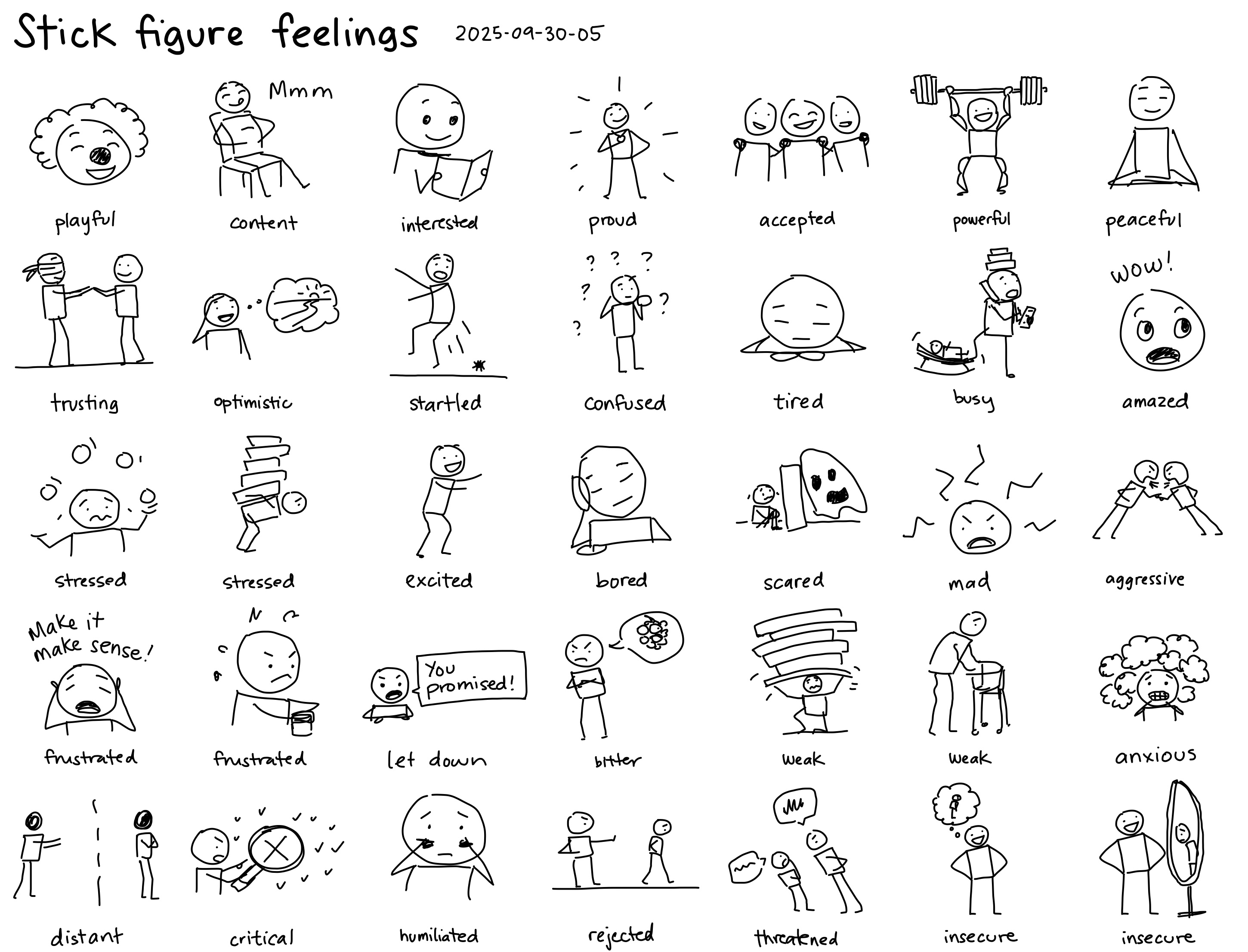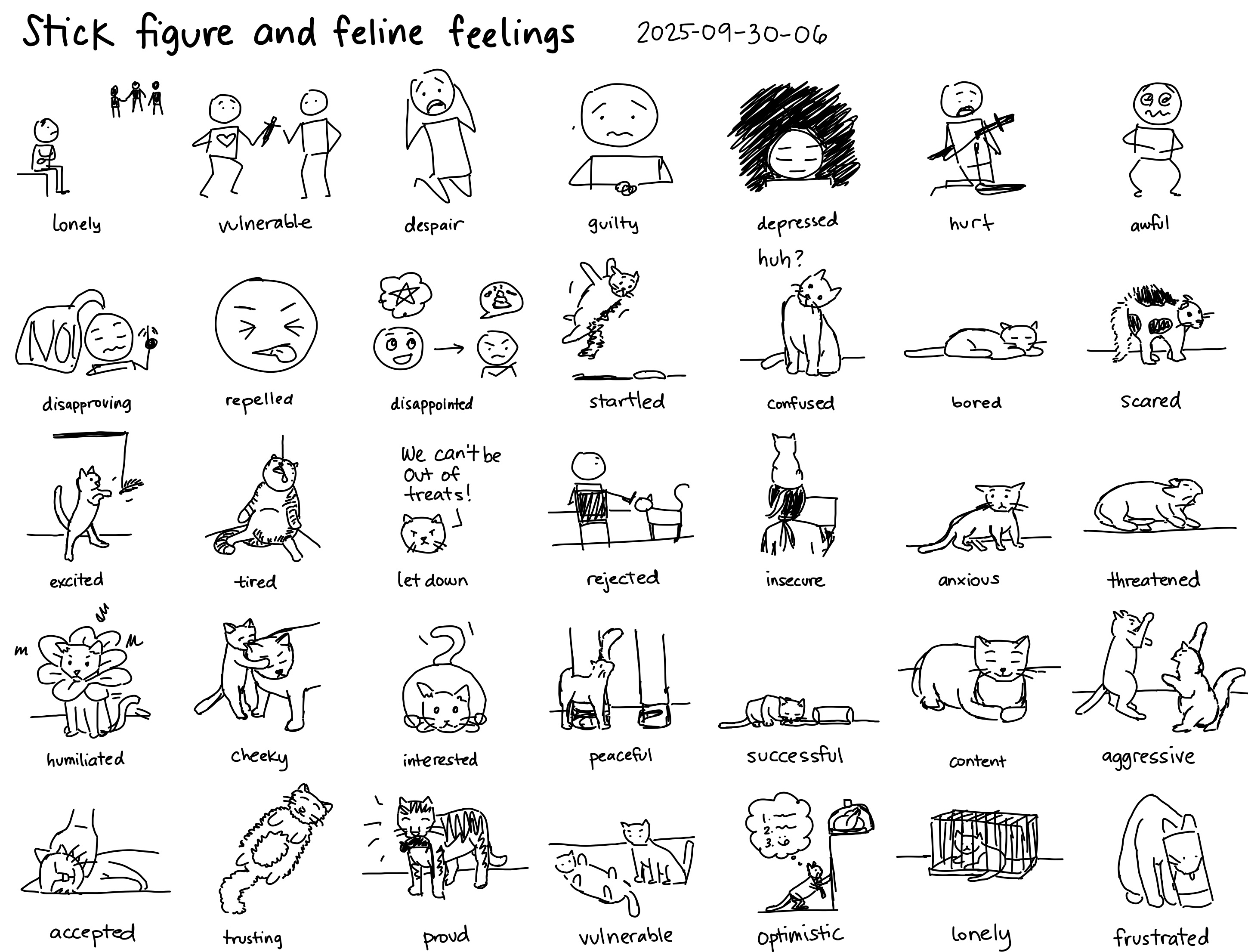Doodling icons in a grid
| drawing, emacsLast week, I experimented with practising drawing little icons as a way of expanding my visual vocabulary.
Making a template
Building on Visual vocabulary practice - ABCs, I decided to make a regular grid that I could then automatically split up into individual images. I used Emacs's svg.el to generate the grid. I started with 4 rows of 7 boxes to match the alphabet example, but I realized that using 5 rows of 7 boxes each would let me reuse the grid for a monthly calendar. I numbered the boxes to make it easier to double-check if the lists line up, but I can write over the numbers for things like dates since the background won't be exported.
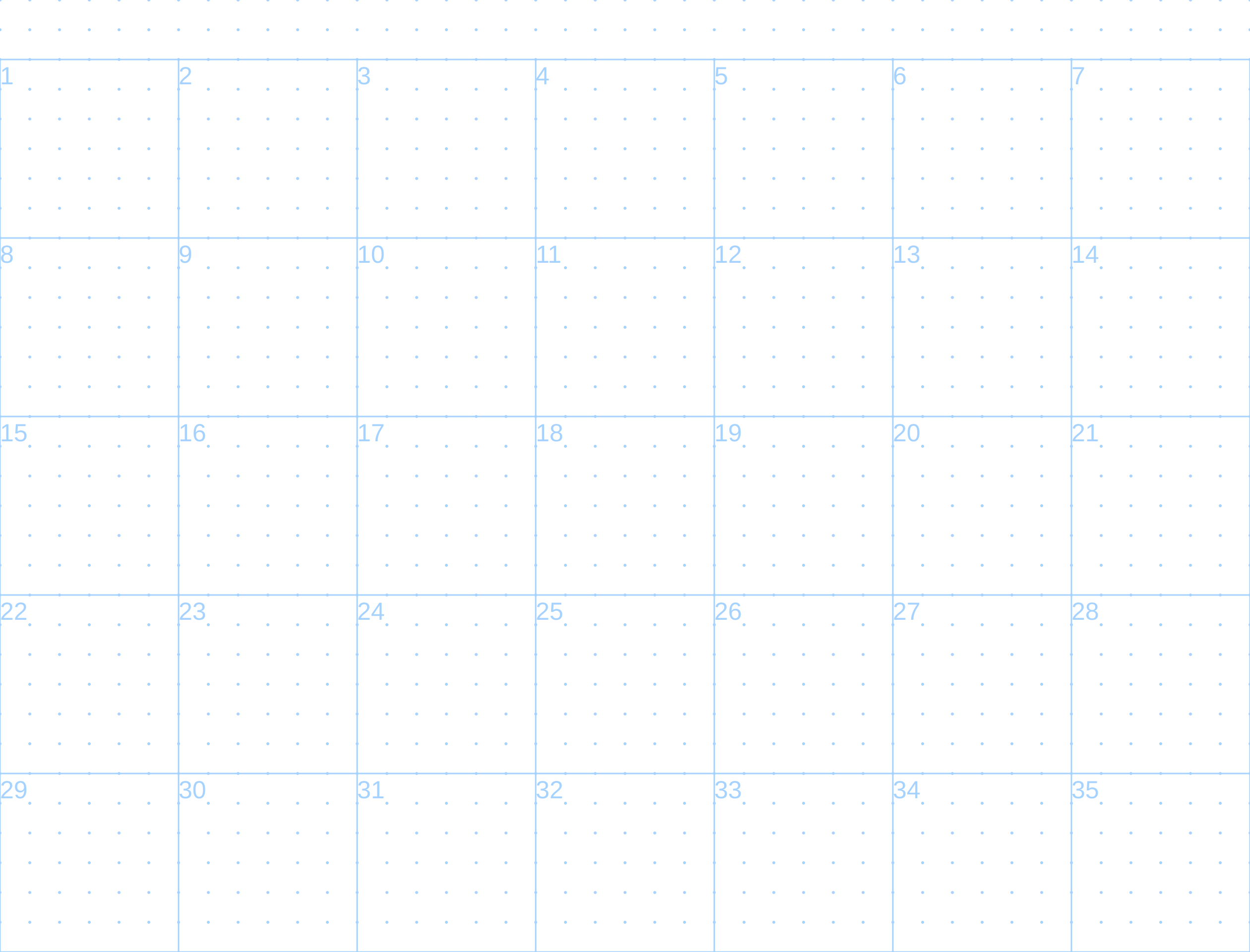
I used convert icon-grid.svg icon-grid.png to
make it from the SVG produced by the following
code.
Code for producing the template
(require 'svg)
(defvar my-dot-grid-boxes-params
'(:num-rows 5
:num-cols 7
:dot-size 3
:line-width 3
:dot-spacing 60
:grid-color "#a6d2ff"
:row-size 6
:col-size 6
:text-size 50
:margin-top 2))
(cl-defun my-dot-grid-boxes-template (&key (num-rows 5)
(num-cols 7)
(dot-size 3)
(line-width 3)
(dot-spacing 60)
(grid-color "#a6d2ff")
(row-size 6)
(col-size 6)
(text-size 50)
(margin-top 2))
"Prepare an SVG with a dot grid within a table with solid gridlines.
Each dot is a solid circle of DOT-SIZE filled with GRID-COLOR spaced DOT-SPACING apart.
The gridlines are also GRID-COLOR. They should divide the image into ROWS and COLUMNS, which are ROW-SIZE * DOT-SPACING and COL-SIZE * DOT-SPACING apart.
The table has a top margin with the dot grid, and this is MARGIN-TOP * DOT-SPACING tall.
All dots are centered on their x, y coordinates.
The rest of the image's background is white."
(let* ((width (* num-cols col-size dot-spacing))
(height (* dot-spacing (+ margin-top (* num-rows row-size))))
(margin-top-height (* margin-top dot-spacing))
(svg (svg-create width height)))
(dotimes (row (+ (* num-rows row-size) margin-top))
(dotimes (col (1+ (* num-cols col-size)))
(let ((x (* col dot-spacing))
(y (* row dot-spacing)))
(svg-circle svg x y dot-size
:fill-color grid-color
:stroke-width 0))))
(when (> text-size 0)
(dotimes (i (* num-rows num-cols))
(let ((x (* (% i num-cols) col-size dot-spacing))
(y (+ margin-top-height (* (/ i num-cols) row-size dot-spacing))))
(svg-text svg
(number-to-string (1+ i))
:x x :y (+ y text-size)
:fill-color grid-color
:font-size text-size
:stroke-width 0))))
(dotimes (col (1+ num-cols))
(let ((x (* col col-size dot-spacing)))
(svg-line svg x margin-top-height x height
:stroke-color grid-color
:stroke-width line-width)))
(dotimes (row (1+ num-rows))
(let ((y (+ margin-top-height (* row row-size dot-spacing))))
(svg-line svg 0 y width y
:stroke-color grid-color
:stroke-width line-width)))
svg))
With that function defined, I can make a template with:
(with-temp-file "~/Dropbox/sketches/icon-grid.svg"
(svg-print
(my-dot-grid-boxes-template)))
I used that template to draw a bunch of little doodles. The Noteful app I use on my iPad makes it easy to import a template and then export my drawings without including the template.
(If this blog post is out of date, you can check the Dot-grid box templates section in my config for my current code.)
I've done this sort of thing before, when I made a font based on my handwriting. That time, I used Python to generate the template with sample characters, and I used Python again to cut the exported image into individual glyphs.
The drawings
Once I imported the template into Noteful, it was easy to draw using fragments of time. 35 boxes are a lot, but each icon was just a few minutes of drawing, and I enjoyed seeing the progress.
Stream of consciousness
Sometimes I drew whatever came to mind:
Text from sketch
Drawing practice 2025-09-24-09
me A+ pizza mom and kid flower witch hat pencil chopsticks rice bowl peach pillow desk fan folding fan pumpkin jack o' lantern ghost taxes broomstick bubbles candy bow bao bowl strawberry tomato cherries cake slice cake
Text from sketch
Drawing practice 2025-09-25-01
mug teacup tempest in a teapot skull poison cauldron tree baseball cap propeller beanie top hat magic magic wand cape playing card hanging towel folded towels soap dispenser bar soap picnic table picnic basket bread croissant donut donut sandwich soup bowl rice and eggs oatmeal
Text from sketch
Drawing practice 2025-09-26-01
clogs slippers slipper tic-tac-toe stockpot skillet crepe pan crepe pancakes cereal sun sailboat crown see saw ice cream cupcake with icing dress and pants rice cooker leap heart heart - anatomical eye headband hairpin bandage glasses glass straw air purifier mask - KN95 pie pie slice pie chart orange lemon
Text from sketch
Drawing practice 2025-09-26-02
trash can garbage can chef's knife paring knife steak knife bread knife butter knife egg egg shells scrambled egg toast bean peas peas hot dog in a bun hot dog octopus avocado taco milk yogurt applesauce chicken drumstick sushi - hand roll lamp present presentation audience applause almond bitter melon oil chopping board partly cloudy rainy cloudy
Learning from books
Other times, I tried systematically going through the doodling books I checked out from the library:
Text from sketch
From "How to Draw Almost Every Day" - Kamo 2025-09-26-05
sake bottle sake cup brush snowflake kite top cat sleeping orange rice cake ornament notebook kimono shopping bag pencil eraser thermometer medicine scarf mittens glove hat boot coat skate snowman shovel washer refrigerator microwave laundry convenience store blimp spatula hot pot bonsai coffee maker
Text from sketch
From "How to Draw Cute Doodles and Illustrations" - Kamo 2025-09-29-05
enjoyment crying happy or asleep making a mistake sleepy yum or cheeky cheerful or excited smiling confusion anger unsettled discomfort front view rear view side view sitting on a chair teacher baby kids (1-3) kids (4-5) walking running jumping raising a hand sitting on the floor swinging singing drawing sunny rain cloudy windy stormy snow moon and stars
Text from sketch
From "How to Draw Cute Doodles and Illustrations" – Kamo 2025-09-30-05
cat cat profile dog dog cat napping cat sitting upright dog dog (fluffy) rabbit monkey mouse cheetah bear raccoon dog fox squirrel lion koala pig elephant sheep giraffe horse bird (front) bird (profile) duck owl swan sparrow nest peacock chicken, chick, egg stork fish whale
Extracting icons from my other sketches
I also extracted the stick figures and cats I'd drawn for different emotions.
Text from sketch
Stick figure feelings 2025-09-30-05
playful content interested proud accepted powerful peaceful trusting optimistic startled confused tired busy amazed stressed stressed excited bored scared mad aggressive frustrated frustrated let down bitter weak weak anxious distant critical humiliated rejected threatened insecure insecure
Text from sketch
Stick figure and feline feelings 2025-09-30-06
lonely vulnerable despair guilty depressed hurt awful disapproving repelled disappointed startled confused bored scared excited tired let down rejected insecure anxious threatened humiliated cheeky interested peaceful successful content aggressive accepted trusting proud vulnerable optimistic lonely frustrated
Splitting up the drawings into individual components
Because I kept all my doodles within the template's boxes, it was easy to split up the images into individual files. First, I needed the text for all the labels. Sometimes I typed this in manually, and sometimes I used Google Cloud Vision to extract the text (editing it a little bit to put it in the right order and fix misrecognized text). Then I used Emacs Lisp to read the labels from the text file, calculate the coordinates, and use ImageMagick to extract that portion of the image into a file. I used filenames based on the label of the individual icon and the ID of the image it came from.
Code for extracting the icons
(cl-defun my-dot-grid-boxes-list (&key (num-rows 5)
(num-cols 7)
(dot-spacing 60)
(row-size 6)
(col-size 6)
(text-bottom 1)
(margin-top 2)
filename
&allow-other-keys)
"Return a list of boxes."
(let* ((margin-top-height (* margin-top dot-spacing))
(max-image-size nil)
(size (image-size (create-image filename nil nil :scale 1) t))
(ratio (/ (car size) (* num-cols col-size dot-spacing 1.0)))
results)
(message "Expected adjusted height %f actual height %f"
(* (+ margin-top (* num-rows row-size)) dot-spacing ratio)
(cdr size))
(dotimes (i (* num-rows num-cols))
(let* ((r (/ i num-cols))
(c (% i num-cols))
(y (* (+ margin-top-height (* r col-size dot-spacing)) ratio))
(x (* c row-size dot-spacing ratio))
(width (* col-size dot-spacing ratio))
(height (* (- row-size text-bottom) dot-spacing ratio)))
(setq results (cons
`((r . ,r)
(c . ,c)
(i . ,i)
(x . ,(floor x))
(y . ,(floor y))
(w . ,(floor width))
(h . ,(floor height))
(x2 . ,(floor (+ x width)))
(y2 . ,(floor (+ y height))))
results))))
(nreverse results)))
(defvar my-sketch-icon-directory "~/sync/sketches/icons")
(cl-defun my-dot-grid-boxes-extract (&rest args &key filename labels
(output-dir my-sketch-icon-directory) force &allow-other-keys)
(let* ((list (apply #'my-dot-grid-boxes-list args))
(base (file-name-base filename))
(ext (concat "." (file-name-extension filename)))
(id
(if (string-match "^[0-9][0-9][0-9][0-9]-[0-9][0-9]-[0-9][0-9]-[0-9][0-9]" base)
(match-string 0 base)
""))
results
args)
(dolist (icon list)
(let-alist icon
(let ((new-filename (expand-file-name
(concat (my-make-slug (elt labels .i)) "--"
id
(format "-%d-%d"
.r .c)
ext)
output-dir)))
(push `((term . ,(elt labels .i))
(icon . ,(file-name-nondirectory new-filename))
(source . ,(file-name-nondirectory filename)))
results)
(when (or force (not (file-exists-p new-filename)))
(setq args
(list (expand-file-name filename)
"-crop"
(format "%dx%d+%d+%d" .w .h .x .y)
"+repage"
new-filename))
(message "%s" (concat "convert " (mapconcat #'shell-quote-argument args " ")))
(apply #'call-process "convert" nil nil nil args)))))
(nreverse results)))
(defun my-dot-grid-boxes-labels (id)
(with-temp-buffer
(insert-file-contents (concat (file-name-sans-extension (my-get-sketch-filename id)) ".txt"))
(goto-char (point-min))
(re-search-forward "^ *$")
(split-string (string-trim (buffer-substring (point) (point-max))) "\n")))
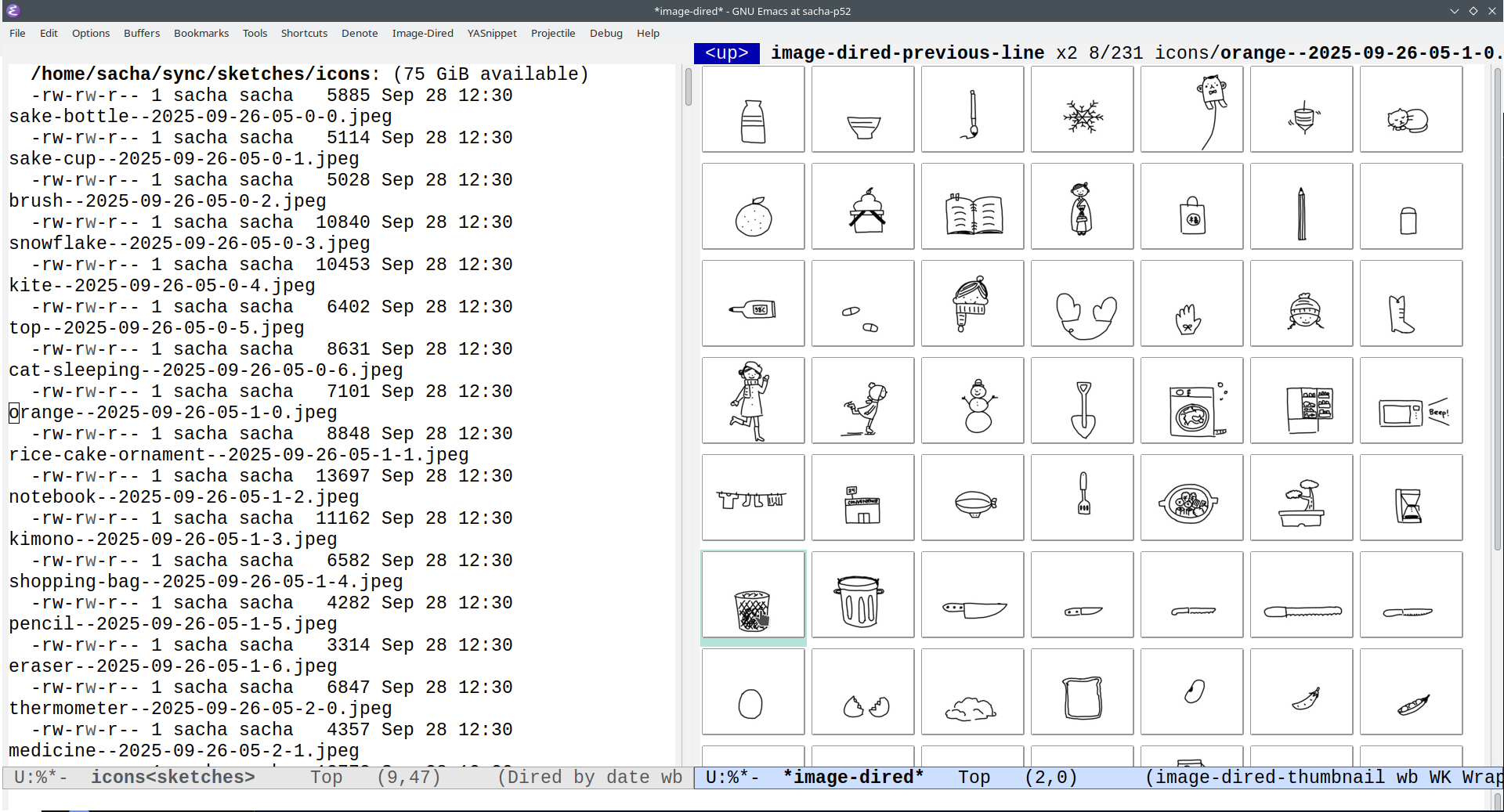
I really liked being able to write code to extract and name images all in one go. If you don't want to dive into Emacs Lisp, though, you can slice up a large image into small ones using ImageMagick.
Thinking ahead: if I use a similar process for my daily drawings, I can extract an "on this day" slice like the one I have for blog posts and sketches (blog post about it).
I had worked on a similar visual vocabulary project in 2013, but I had made it as a shared notebook in Evernote. That's gone now, and I can't remember if I backed it up or where I would've saved a backup to. Ah well, no harm in starting again, with files under my control.
Looking up images
Now that I'd broken down the images into labelled components, I wanted to be able to quickly look up icons from a web browser; my own version of The Noun Project. First, I exported the label information into a JSON.
Code for processing a sketch and updating the index
(defun my-sketch-icon-update-index (list)
(let (data
(index-file (expand-file-name "index.json" my-sketch-icon-directory)))
(with-temp-file index-file
(setq data
(if (file-exists-p index-file)
(json-read-file index-file)
'()))
(dolist (entry list)
;; Remove current entry
(setq data (seq-remove (lambda (o)
(and (string-match (regexp-quote (alist-get 'source o)) (alist-get 'source entry))
(string= (alist-get 'term o) (alist-get 'term entry))))
data))
;; Add a new entry
(push
`((term . ,(alist-get 'term entry))
(icon . ,(alist-get 'icon entry))
(source . ,(alist-get 'source entry)))
data))
(insert (json-encode (sort data :key (lambda (o) (alist-get 'term o)) :lessp #'string<))))))
(defun my-dot-grid-boxes-process (id &optional force)
(interactive
(list
(my-complete-sketch-filename "drawing")
current-prefix-arg))
(let* ((labels (my-dot-grid-boxes-labels id))
list)
(cl-assert (= (% (length labels) 7) 0))
(cl-assert (> (length labels) 1))
(setq list
(my-dot-grid-boxes-extract :output-dir my-sketch-icon-directory
:num-rows (/ (length labels) 7)
:filename (my-get-sketch-filename id)
:labels labels
:force force))
(my-sketch-icon-update-index list)))
(defun my-dot-grid-boxes-process-all-icons ()
(interactive)
(dolist (source (my-sketches "icons")) (my-dot-grid-boxes-process source)))
Then I made a simple interface for looking up icons.
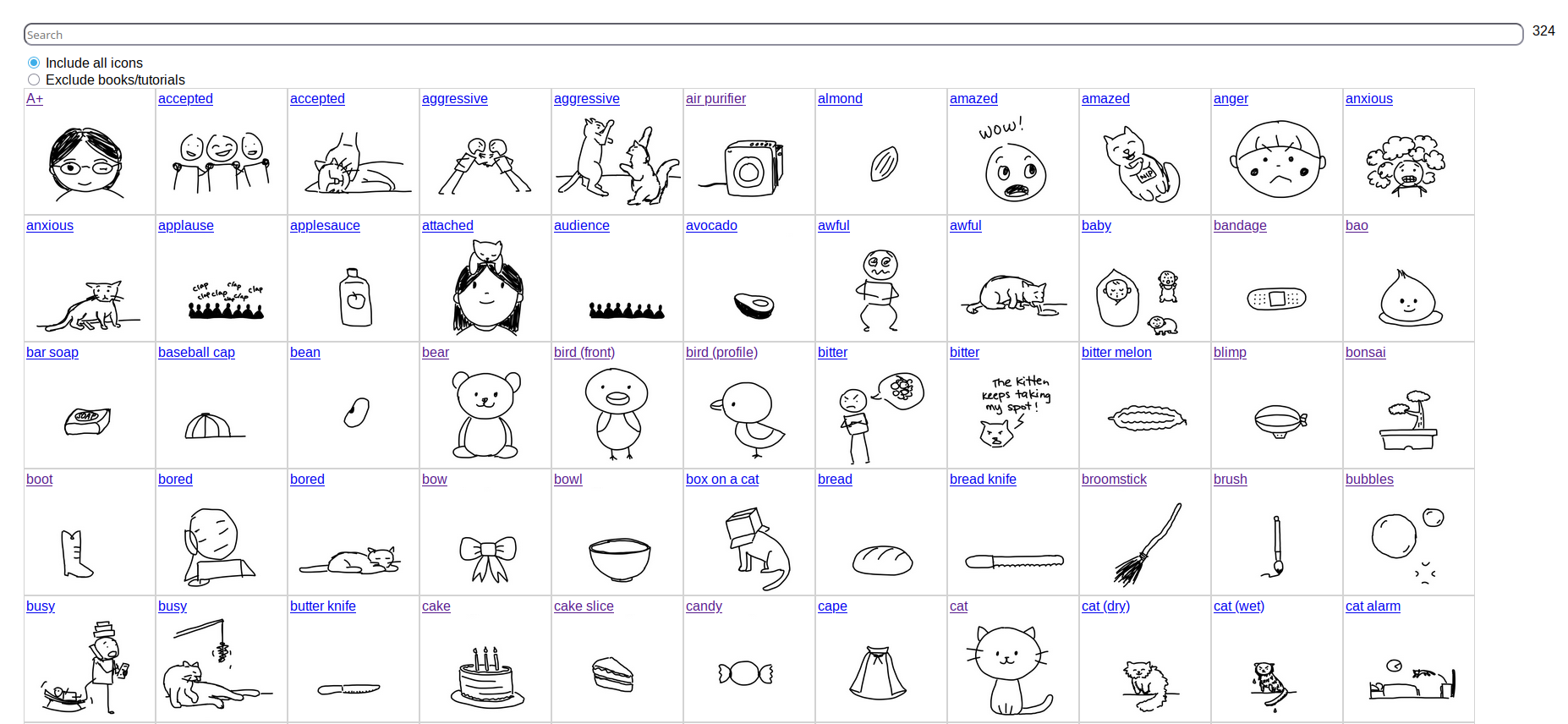
I can filter it by terms, and I can exclude the icons I've copied from illustration books for practice.
I can even use it as a rudimentary visual menu for showing A+ some choices.
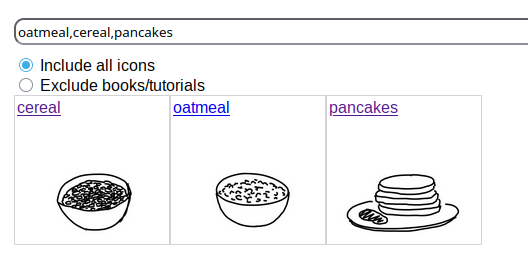
Reflections on doodling
My curves are shaky. I'm mostly learning to ignore that and draw anyway. Good thing redoing them is a matter of a two-finger tap with my left hand, and then I can redraw until it feels mostly right. I try up to three times before I say, fine, let's just go with that.
I often draw with my iPad balanced on my lap, so there's an inherent wobbliness to it. I think this is a reasonable trade-off. Then I can keep drawing cross-legged in the shade at the playground instead of sitting at the table in the sun. The shakiness is still there when I draw on a solid table, though. I have a Paperlike screen protector, which I like more than the slippery feel of the bare iPad screen. That helps a little.
It's possible to cover it up and pretend to confidence that I can't draw with. I could smooth out the shakiness of my curves by switching to Procreate, which has more stylus sensitivity settings than Noteful does. A+ loves the way Procreate converts her curves to arcs. She moves the endpoints around to where she wanted to put them. I'm tempted to do the same, but I see her sometimes get frustrated when she tries to draw without that feature, and I want to show her the possibilities that come with embracing imperfection. It's okay for these sketches to be a little shaky. These are small and quick. They don't have to be polished.
The Internet says to draw faster and with a looser grip, and that lots of practice will build fine motor skills. I'm not sure I'll get that much smoother. I think of my mom and her Parkinson's tremors, and I know that time doesn't necessarily bring improvement. But it's better to keep trying than to shy away from it. Maybe as I relax more into having my own time, working on my own things and moving past getting things done, I'll give myself more time for drawing exercise, like filling pages with just lines and circles.
Reflections on sources
I had fun coming up with words and drawing them. I could start with whatever was in front of me and go from there. I used my phone to look up the occasional reference image, like the heart. Sometimes A+ suggested things to draw. Sometimes she even took over.
The books were handy when I didn't feel like thinking much. I could just reproduce the already-simplified drawings. I often felt like I still wanted to tweak things a bit more to make them feel like my own, though, which was a useful way to figure out more about what I like.
Instead of mimicking other people's sketches, I can mine my sketchnotes and pull out the concepts I tend to think about a lot. If I've drawn them in Noteful, I can even copy them from their original sketches, resize them, and make the lines a consistent thickness. If I've drawn them elsewhere, it's easy enough to redraw.
Other resources
Ellane W's mustache post reminded me that Inktober has just started, so that's another source of ideas. Zsolt's 2021 post on sketchnoting for PKM led me to Quick, Draw!, which has 345 simple drawing prompts I can try. There's also a TU Berlin dataset with 250 drawing prompts. SketchDaily Reference Site could be good for randomness and inspiration, too.
Building a visual library is a great way to learn how to actually draw things. I'm curious about using this 30-minute drawing exercise to start paying attention to a few things, and maybe using the shrimp method if there's something I really want to nail down. Visual mnemonic links might be a way to explore the connections between things as I wander around ideas (even though this video is way more advanced than I am).
Next steps
I think I'll keep drawing these visual vocabulary practice sketches, focusing more on my own ways of drawing. It's fun. I have 324 icons at the moment. I wonder what the collection will be like when I have a thousand terms in it.
On the Emacs side, it might be interesting to quickly add a related doodle to the margin of a blog post, or to look up or copy a personal reference image as I untangle my thoughts in a sketch. I'm tempted to write some Emacs Lisp that searches for these terms in my draft blog posts and adds a little hint whenever it finds a match. Another small piece of code might identify recurring nouns and verbs in recent posts and suggest those if I haven't drawn them yet. Could be fun.
Check out my icon library if you're curious!

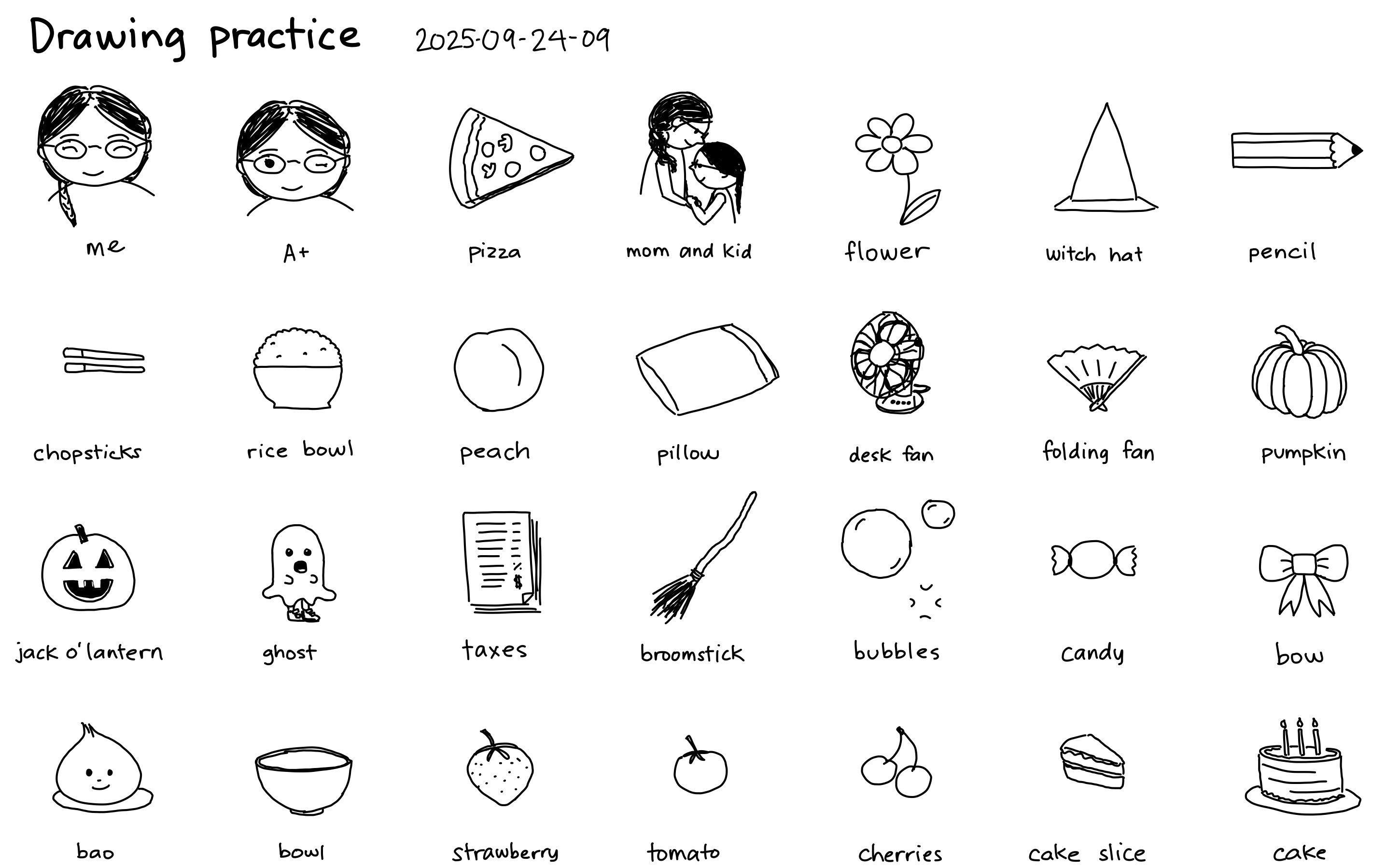
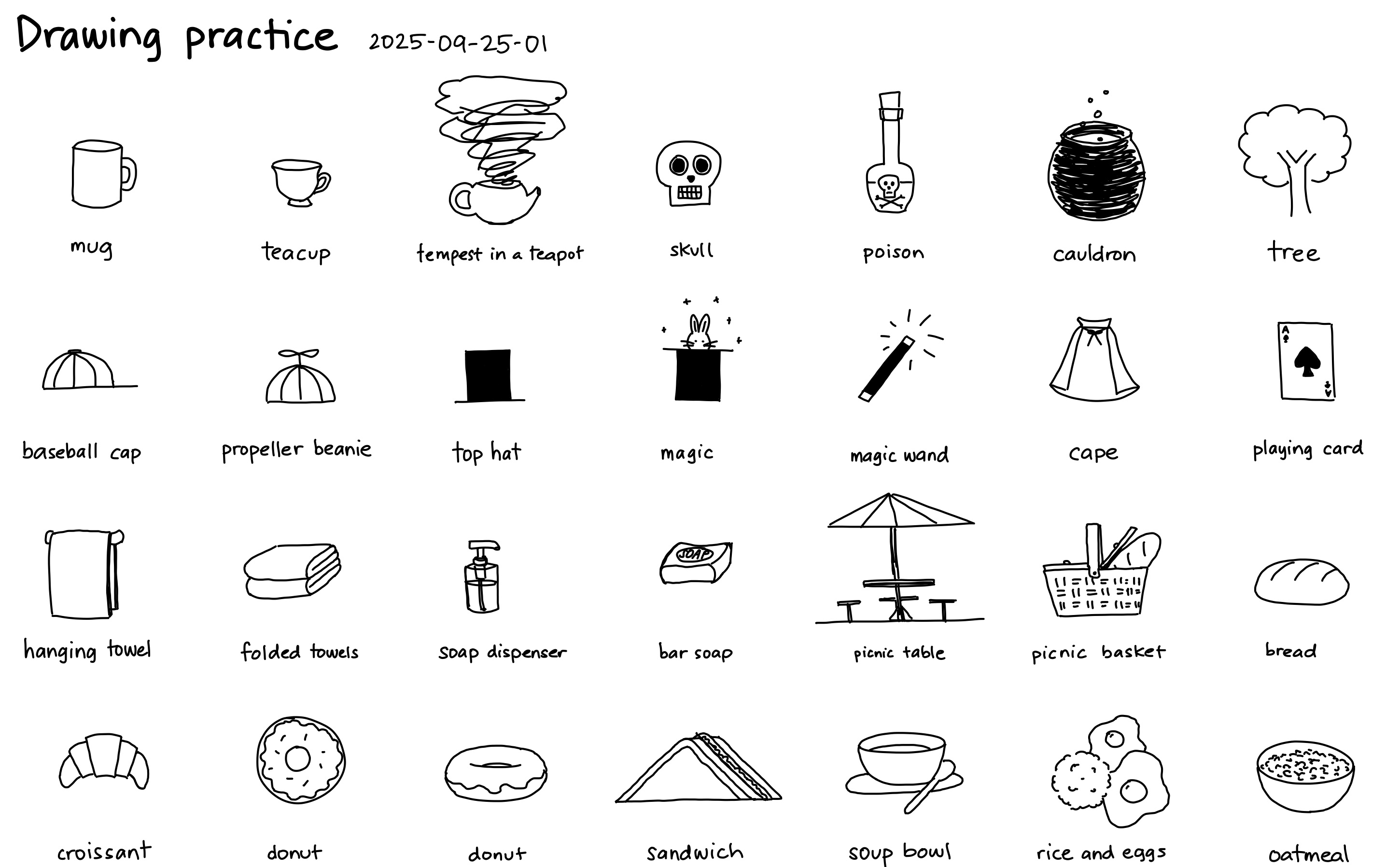
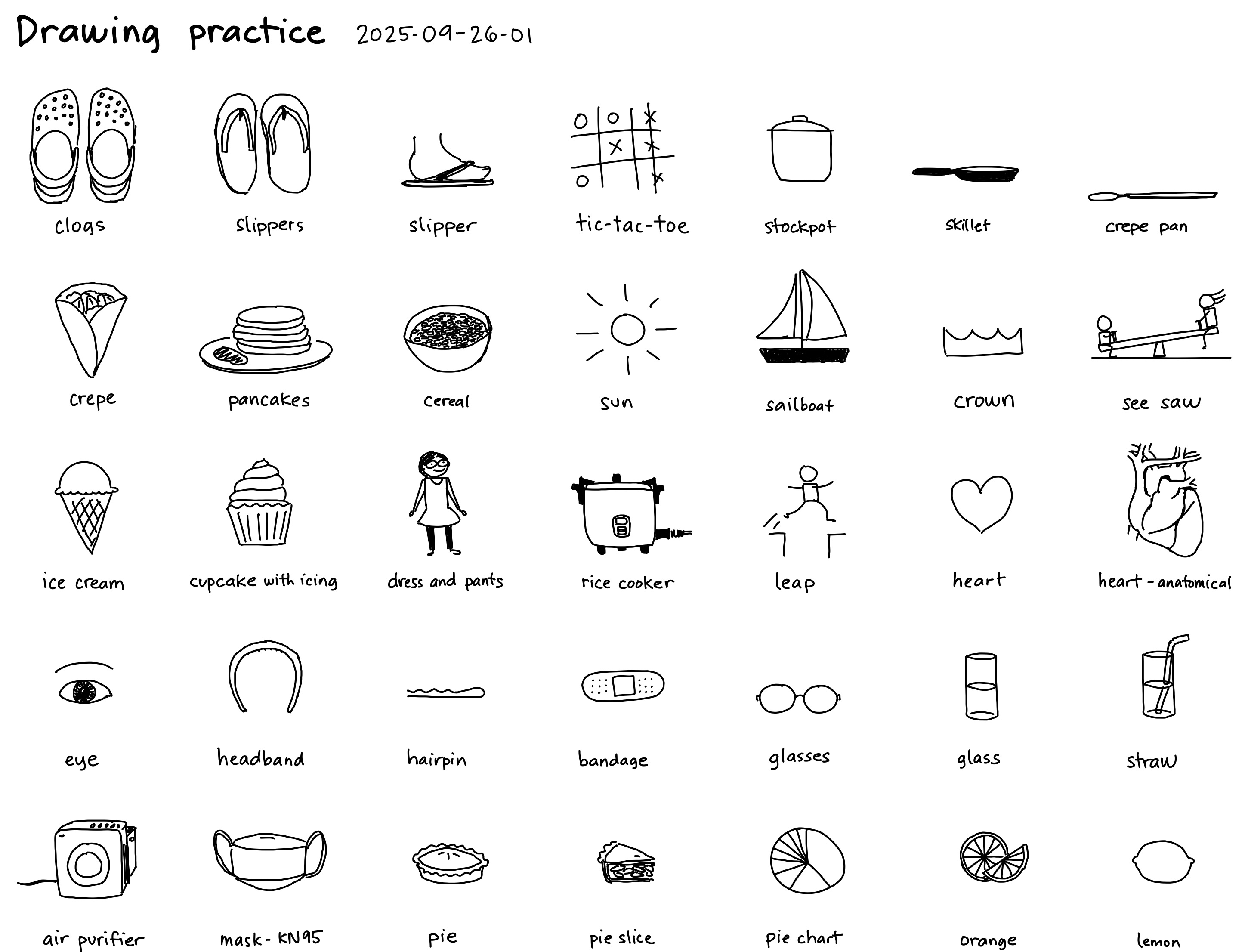
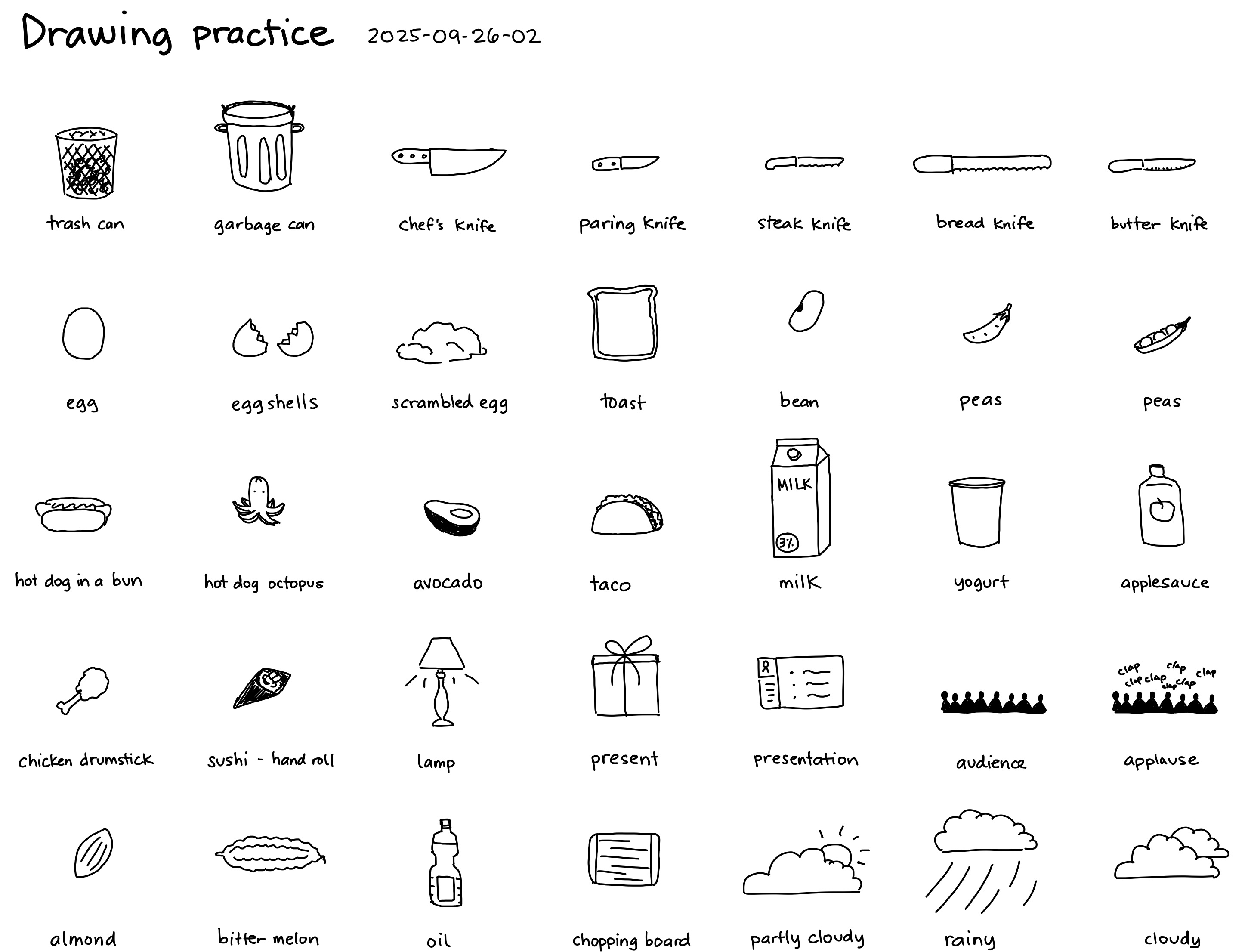
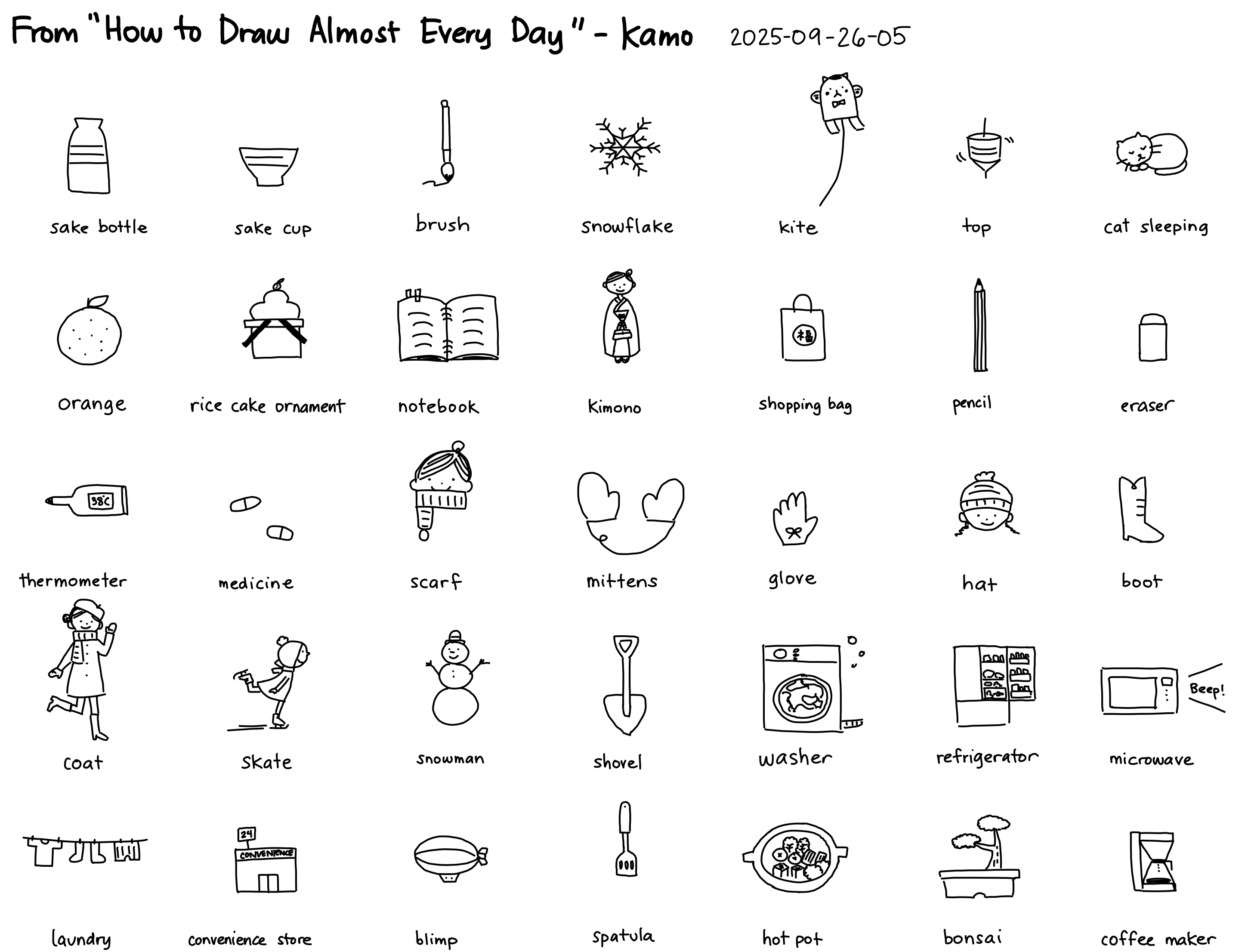
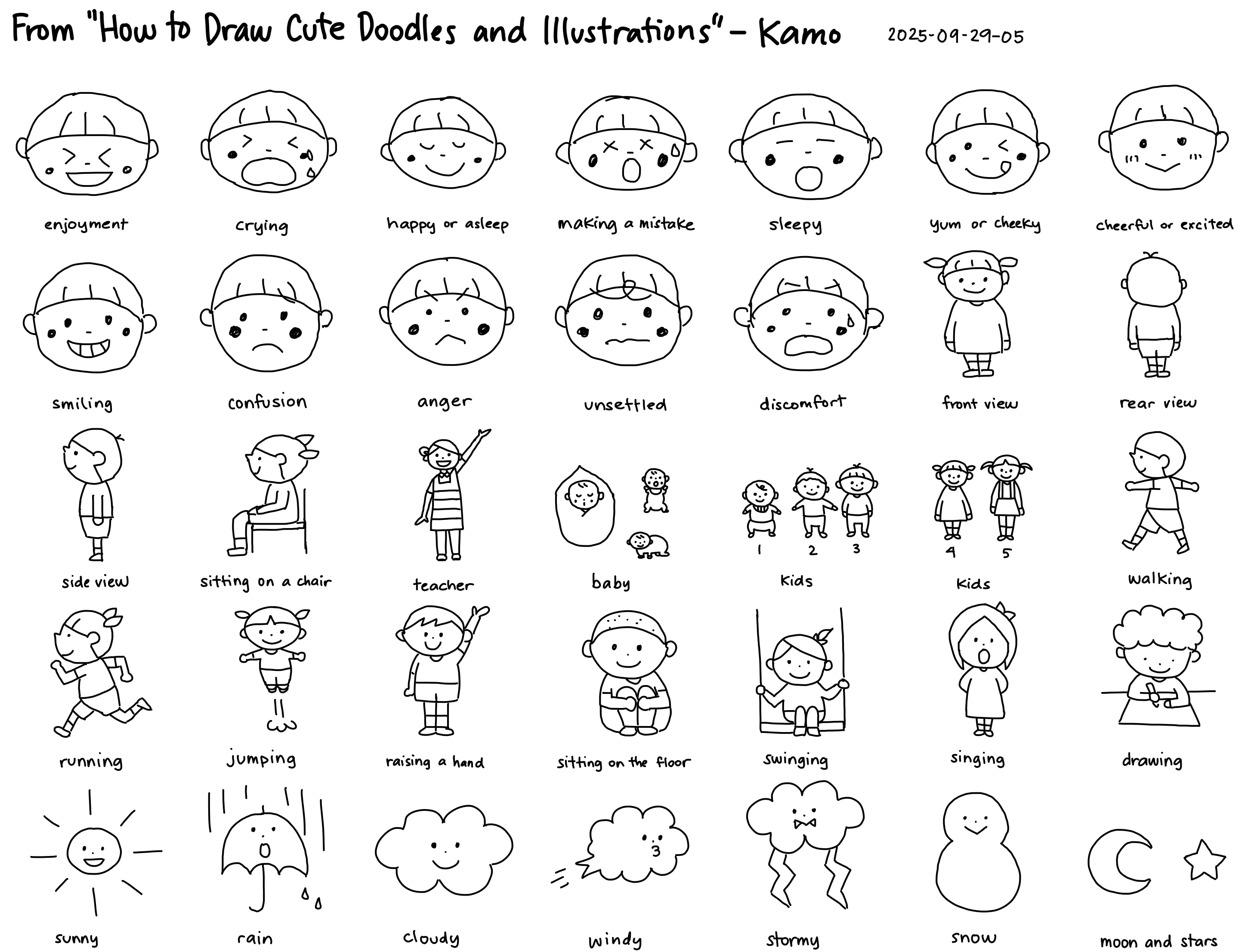%20--%20drawing%20icons.jpeg)
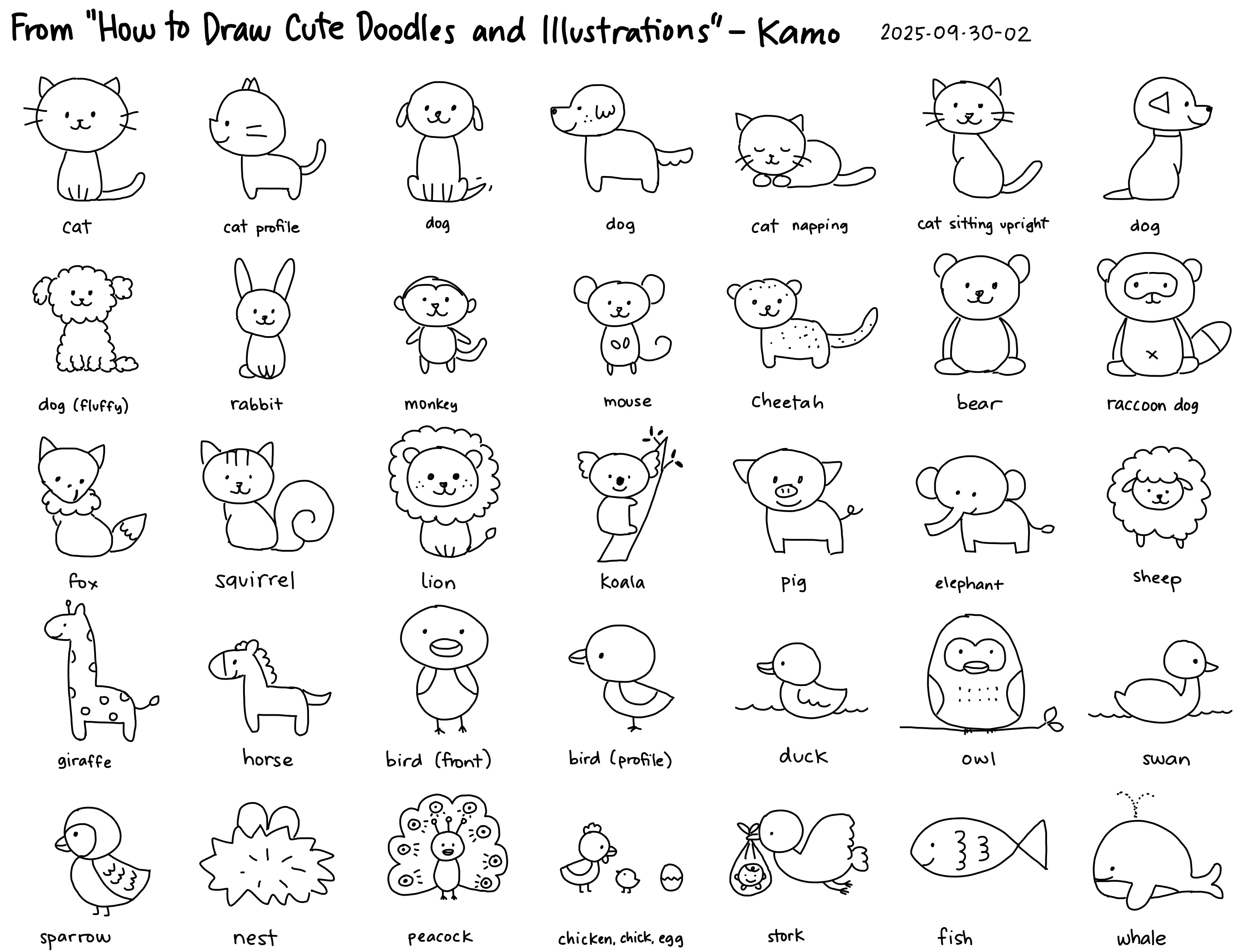%20--%20drawing%20icons.jpeg)
